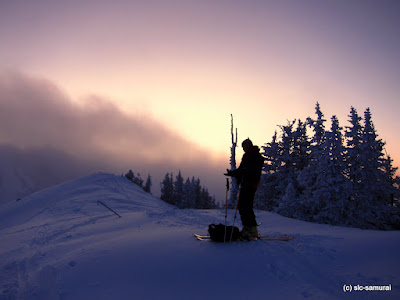The other night, I pulled out my bathroom scale and weighed some gear. Using a Sharpie, I wrote the weight on each piece. The Insanes (the big fat ones) aren't mine, but I labeled them anyway . . . .
 |
| From December 23, 2009 |
Ski Weights:
164 Trab Duo Race w/ Low Techs: 2.1 lbs per ski, 64 mm at waist, race and fast touring.
160 Dynafit SR 11 w/Low Techs: 2.3 lbs per ski, 62 mm at waist, race and fast touring.
172 Dynafit ST 7 w/TLT Speeds: 3.6 lbs per ski, 74 mm at waist, fast touring, spring.
169 Dynafit Manaslu w/TLT Vertical: 3.8 lbs per ski, 95 mm at waist, touring, powder.
173 BD Havoc w/Dynafit Comforts: 4.7 lbs per ski, 88 mm at waist, rock skis.
183 Voile Insane w/TLT Speeds: 4.8 lbs per ski, 120 mm at waist, ????.
 |
| From December 23, 2009 |
Boot Weights:
Dynafit Zzero, four buckle, 3.6 lbs
Scarpa F1, 2 buckle, 2.8 lbs (I have modified F1s that I got down to 2 lbs)
Pierre Gignoux 444, 2 buckle, 1.4 lbs
 |
| From December 23, 2009 |
Skin Weights:
Pomoca Race for 160 cm skis: .2 lbs
Dynafit Speedskins for 160 cm skis: .3 lbs
BD Mohair Mix cut for Dynafit ST 7s: .6 lbs
BD Glidelite cut fo Havocs: .7 lbs
BD Ascension cut for Manaslu: .7 lbs
There are a lot of combinations with these skis, boots, and skins. At the lightest end of the spectrum, the Trabs with PG 444s and Pomoca skins weigh 3.7 pounds per foot. Contrast that with the Manaslus, Zzeros, and BD skins at 8.1 pounds per foot. That's a difference of 4.4 pounds per foot or 219 percent heavier -- huge, especially during a long tour. If you think about it in pounds lifted per vertical foot, over a 10k vertical tour, that's a difference of 44,000 lbs! I plan on using F1s with the Manaslus and will get some Dynafit Speedskins, which will bring the weight down to about 7 lbs per foot.
One might suggest that the comparison above is misleading because my race setup is stupid light. To a certain extent, I might agree, but the fact is, I tour a lot in that setup and have skied every condition imaginable in that setup. Can I straightline Cardiac Bowl in that setup? No. Can I competently ski down Cardiac Bowl or a steep chute in that setup and have fun? Absolutely. In fact, there are several ski mountaineers like Benedikt Bohm who have set speed records up and down 8000 meter peaks on similar setups. That said, there are times when a race setup does not make sense, like on a big powder day. Breaking trail on 65 mm waisted skis doesn't work that well. And going down in 2 ft of fluff in that kind of setup is way too '80s and a bit irreverent.
Enter the Manaslus, or my "fat" setup. Manaslus, F1s/Zzeros, and BD Ascensions are quite light. There are very few, if any, 95 mm waisted skis out there that are as light as the Manaslu. The Voile Insanes might come close. I think Goode and DPS make some light carbon skis that have some girth. Obviously, any setup that doesn't incorporate Dynafit bindings is more than a pound per foot heavier and, quite frankly, a waste of energy. My guess is that most conventional backcountry setups are in the 9 to 12 lb range. The Havocs, which are skinnier and which I used for years, are a full pound heavier.
My friend Joey and I were laughing the other day about our touring setups in 2002. I was on Scarpa T1s, Voile Mtn. Surfs/Rossis/Tuas, and Hammerhead bindings. I think the Mtn Surfs and Hammerheads alone were over 8 pounds. The T1s were probably another 5. And that setup didn't even have a free pivot. Uggh.
Assuming the goal is going faster, higher, and longer (and not making turns with "soul"), I think the question that should dictate backcountry ski choice is: what can I get away with? This is a loaded question because the answer depends on lots of things like conditions, partners, terrain, route, distance, time, skill, and binding choice. But generally speaking, in my not-so-humble opinion, most of us American backcountry travelers can get away with a lot less than we have or think. In my mind, the less you can get away with, the better -- you'll go faster, higher, and longer.


















